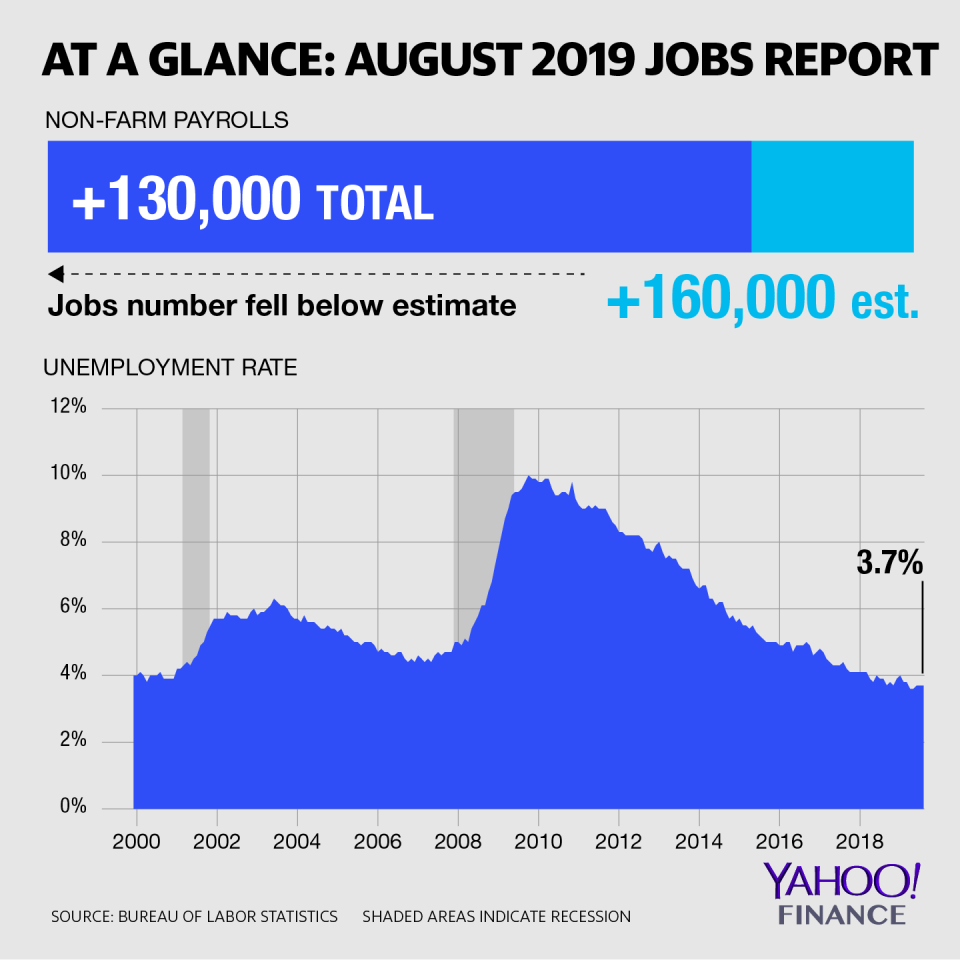Jobs report: U.S. economy adds fewer payrolls than expected in August
The U.S. economy added fewer than expected jobs in August.
Here were the key employment figures from August, compared to Bloomberg-compiled estimates:
Nonfarm payrolls added: 130,000 vs. 160,000 expected
Unemployment rate: 3.7% vs. 3.7% expected
Average hourly earnings MoM: 0.4% vs. 0.3% expected
Average hourly earnings YoY: 3.2% vs. 3.0% expected
July’s employment figure was revised to 159,000, down from the 164,000 positions previously reported. The labor force participation rate ticked higher to 63.2%. The manufacturing sector added 3,000 positions in August.
The retail sector lost 11,000 jobs during the month. Retail payrolls fell for the seventh consecutive month, the longest losing streak since 2009.

Investors cheered and stock futures rose as the weaker-than-expected jobs report all but cemented the possibility of a second interest rate cut. The August jobs report comes at a critical time, as trade tensions, slowing global growth and overall uncertainty keep investors on edge. August was a brutally volatile month for the stock market with wild swings in both directions. In addition, with multiple brief inversions of the yield curve during the month, fears of a possible recession sent market watchers into a frenzy.
“Amid the volatility of financial markets seeming to mirror the rest of the world, the U.S. job market has remained a veritable pillar of stability,” Mark Hamrick, Bankrate.com’s senior economic analyst, wrote in an email to Yahoo Finance. “In terms of relatively stability, the upcoming August employment reading should be no exception, with the emphasis on ‘should.’ The key question is whether the U.S. economy continues to grow in the face of these headwinds.”
Though consensus estimates called for a decline in job additions from last month, some economists were predicting a much healthier picture for the overall labor market.
Morgan Stanley economist Ellen Zenter predicted that the U.S. economy would add a cool 181,000 jobs in August. “Most key data on the labor market for August out so far have sent rather positive signals,” Zenter wrote in a note to clients Thursday. For one, in the July survey week, initial jobless claims continued to run at low levels and there were no particular indications that the rate of hiring might have slowed markedly. Secondly, the August labor market differential reported by the Conference Board rose to a multi-year high again. Thirdly, the ADP employment report surprised to the upside with underlying strength being rather broad based. Together, these point to still healthy underlying labor market conditions.”
On the other hand, Wells Fargo economist Sam Bullard predicted that only 135,000 jobs were added in August. “Monthly job gains have slowed so far this year, yet the underlying pace is still solid enough to promote moderate GDP growth,” Bullard wrote in a note Thursday. “That said, the U.S. labor market is not immune to the deceleration in the pace of overall economic growth we have seen recently, and will ultimately show up in future hiring plans.”
The BLS report comes after a new report from ADP Research Institute and Moody’s on Thursday showed that job growth in the U.S. private sector was better than economists’ expectations in August. The U.S. private sector added 195,000 positions in August, higher than the 148,000 positions Wall Street was predicting.
July’s figure was revised down to 142,000, from the 156,000 positions that was initially reported.
“In August we saw a rebound in private-sector employment,” Ahu Yildirmaz, vice president and co-head of the ADP Research Institute said in a statement. “This is the first time in the last 12 months that we have seen balanced job growth across small, medium and large-sized companies.”
Mark Zandi, chief economist of Moody’s Analytics, added, “Businesses are holding firm on their payrolls despite the slowing economy. Hiring has moderated, but layoffs remain low. As long as this continues recession will remain at bay.”
Though the ADP report is not always a reliable indicator of what the Bureau of Labor Statistics (BLS) report will illustrate, it does provide a bit of insight into the health of employment in the U.S.
—
Heidi Chung is a reporter at Yahoo Finance. Follow her on Twitter: @heidi_chung.
More from Heidi:
Read the latest stocks and stock market news from Yahoo Finance
Follow Yahoo Finance on Twitter, Facebook, Instagram, Flipboard, LinkedIn, and reddit.


